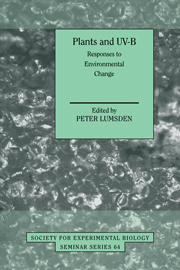Book contents
- Frontmatter
- Contents
- List of contributors
- Preface
- PART I The ozone layer and UV-B radiation
- PART II Effects of UV-B on plants at the cellular level
- PART III Effects of UV-B at the whole plant and community level
- Effects of solar UV-B radiation on aquatic ecosystems
- Assessing the impact of UV-B radiation on the growth and yield of field crops
- Effects of UV-B radiation on plants from agro- and natural ecosystems
- Effects on subarctic vegetation of enhanced UV-B radiation
- Impacts of elevated UV-B on forest ecosystems
- Effects of elevated UV-B radiation and elevated CO2 on heathland communities
- Alterations in competitive balance
- Interations between trophic levels
- Index
Effects of elevated UV-B radiation and elevated CO2 on heathland communities
Published online by Cambridge University Press: 04 August 2010
- Frontmatter
- Contents
- List of contributors
- Preface
- PART I The ozone layer and UV-B radiation
- PART II Effects of UV-B on plants at the cellular level
- PART III Effects of UV-B at the whole plant and community level
- Effects of solar UV-B radiation on aquatic ecosystems
- Assessing the impact of UV-B radiation on the growth and yield of field crops
- Effects of UV-B radiation on plants from agro- and natural ecosystems
- Effects on subarctic vegetation of enhanced UV-B radiation
- Impacts of elevated UV-B on forest ecosystems
- Effects of elevated UV-B radiation and elevated CO2 on heathland communities
- Alterations in competitive balance
- Interations between trophic levels
- Index
Summary
Introduction
Penetration of harmful ultraviolet-B (UV-B) radiation (280–320 nm) to the earth's surface is limited by stratospheric ozone. However, ozone depletion, caused by the emission of synthetic chlorofluorocarbons and related compounds, is currently estimated at 4–5% per decade at UK latitudes (Stolarski et al, 1992; Herman, McPeters & Larko, 1993). If the Montreal Protocol continues to be implemented, a possibility that remains uncertain (Greene, 1995; Jordan, 1995), concentrations of chlorine and bromine compounds may reach a maximum in the stratosphere around 1998. Thus, ozone depletion may peak within the next decade, followed by a slow recovery over the next 50 years (Madronich et al, 1995). Despite this more optimistic outlook, other factors such as exaggerated springtime ozone loss in the Arctic due to global warming (Austin, Butchart & Shine, 1992) may need to be considered. In addition, yearly mean ozone depletion figures conceal considerable variation in depletion with season, with maximal losses in late winter and spring (Niu et al., 1992; Herman, McPeters & Larko, 1993; Reinsel et al, 1994), although at that time of year the level of UV-B is relatively low. This evidence suggests that the potential for increasing levels of UV-B over Northern latitudes will remain a problem for many years to come. Many studies on the effects of UV-B on plants have been conducted in controlled environment cabinets or greenhouses, where the levels of UV-A (320–400 nm) and PAR (400–700 nm) may be low compared to the field.
- Type
- Chapter
- Information
- Plants and UV-BResponses to Environmental Change, pp. 283 - 304Publisher: Cambridge University PressPrint publication year: 1997
- 5
- Cited by



